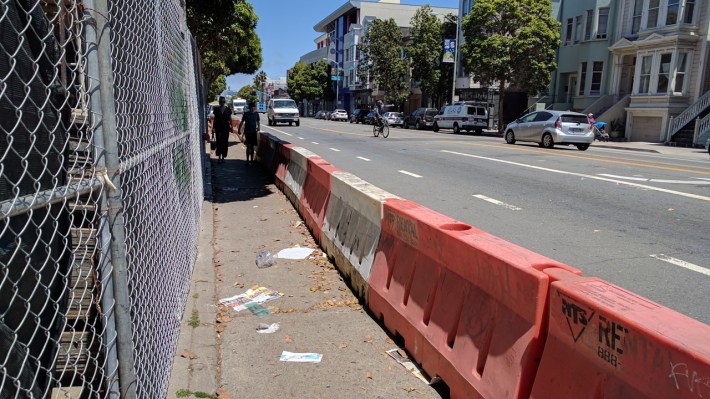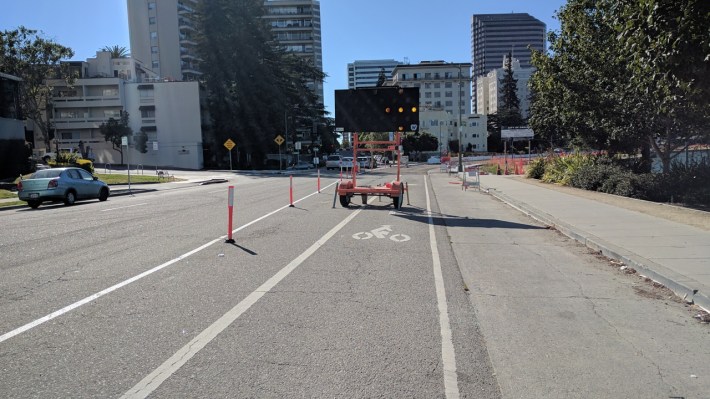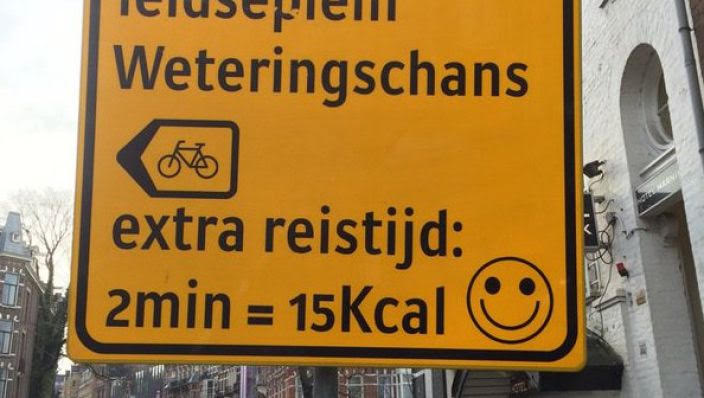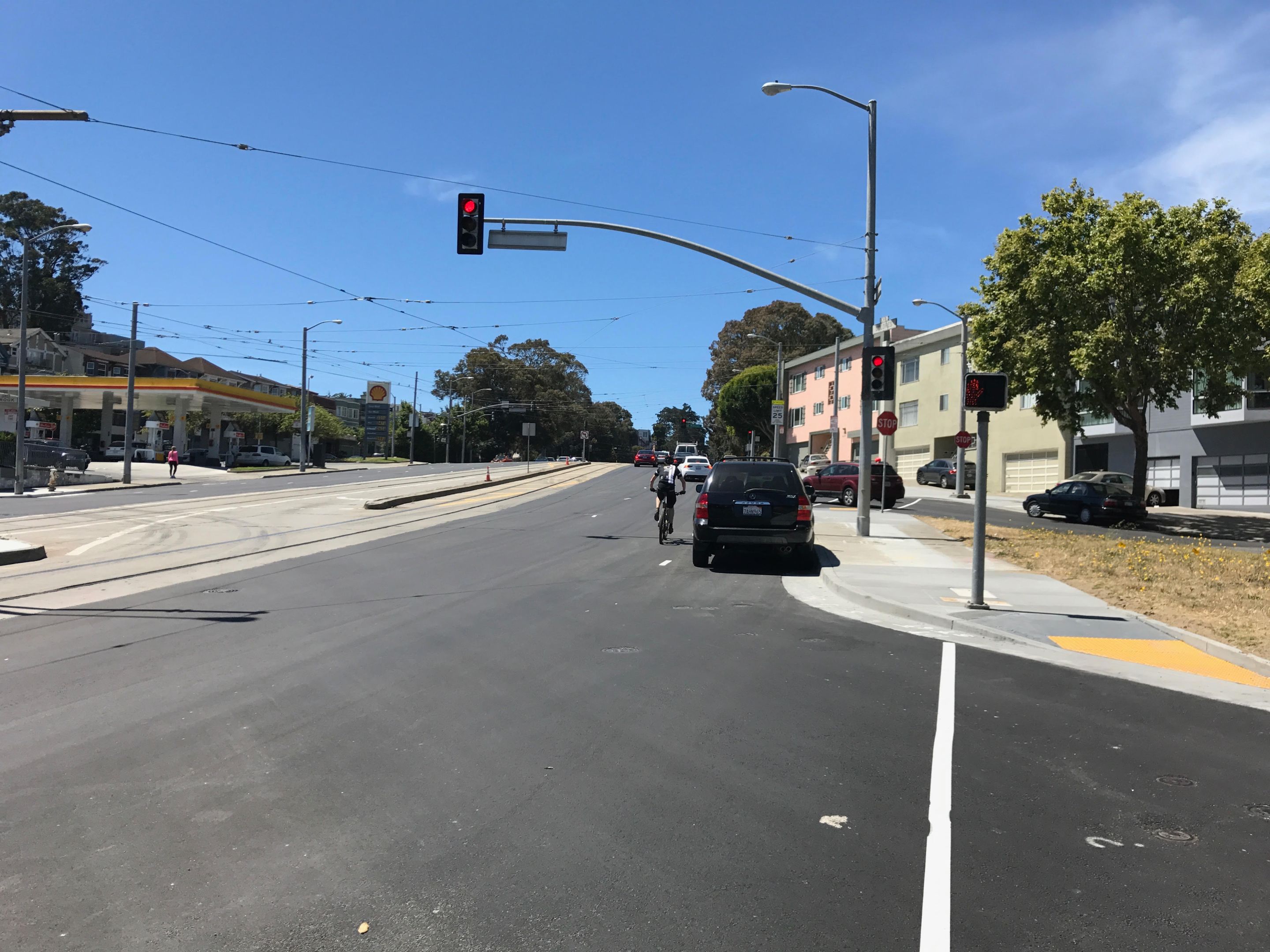Streetsblog tipster Dan Crosby brought this to our attention: due to road work on San Jose, the intersections with Guerrero and Dolores are even more confusing and dangerous for people on bikes.
From Crosby's email to Streetsblog:
There’s been some major (and much-needed) repaving work done recently on San Jose and Guerrero, between Cesar Chavez and Arlington. Overall it’s been communicated well but IMHO they’ve messed up one piece of it badly for biking: on southbound San Jose south of 30th, there’s a pretty clearly delineated (but not really marked as such) bike lane next to the curbside parking. But the bike lane is not otherwise painted, and at the island at San Jose and Dolores, it just continues into where there used to be a couple of parking spots next to the island. That area and lane are not marked at all, so of course people started parking in it the instant the lanes were reopened. The effect is a bike lane that disappears for three car lengths.
That kind of confusion can quickly turn deadly. "Today it almost got me hit by an SUV turning right from Dolores onto San Jose without looking," continued Crosby. "I assume the driver just didn’t look left because there were parked cars there."
Streetsblog explored the area several times last week. On one of the visits, a crew was putting down temporary striping for the bike lane. However, the safe-hit posts that once protected the bike lane on San Jose were gone and the crew had no idea when (or if) they would be replaced when the repaving was done. Streetsblog has reached out to SFMTA for more information and will update accordingly. Please comment below if you've been through that area this week and noticed any progress.
The good news is the repaving appears to be part of ongoing efforts to make San Jose Avenue safer. That is welcome, of course. However, Crosby's brush with death forces us to ask why construction crews often do so little (or nothing at all) to maintain throughput and safety when it comes to bicycles.
Automobiles always get cones, signs and markings to help them navigate around construction. Even when it comes to sidewalks, construction crews in San Francisco and Oakland seem to do much better--they place physical barriers in the street, complete with temporary ramps for wheel chairs, so that people walking can still get where they need to go in relative safety. It's not always pretty, but it seems basically safe, such as with this temporary sidewalk on Valencia near a construction site:

Streetsblog has also observed this kind of pedestrian detour treatment in Oakland on Broadway and in a few other locations and cities. As a partial aside, one does have to wonder, why didn't they put the barrier a little to the left so cyclists could use it too (with some posts to segregate cyclists and pedestrians)? For that matter, why can't cities use these same barriers to set up protected bike lanes quickly, while they look for more permanent solutions?
But here is what's typical for how construction crews, throughout the Bay Area and elsewhere in California, treat bike lanes--this photo, along Lake Merritt in Oakland, was taken yesterday:

Ironically, this is part of the Lakeside Green Street/Snow Park project, which should make Lakeside safer for cyclists and pedestrians. So as with San Jose Avenue in San Francisco, it's great that the work is getting done. It's just odd that the construction crews don't seem obligated to maintain some kind of temporary bicycle infrastructure or decent detour/way-finding for bikes in the meantime.
"Last year I worked with the new Oakland DOT ... to develop new construction staging standards to protect bike, walk, and transit access," wrote Robert Prinz, Education Director for Bike East Bay, in an email to Streetsblog. "These standards are great, as they prioritize keeping sidewalks and bike lanes open ahead of extra travel lanes, especially in busier parts of town where the facilities are most needed. However, the standards are only useful if they're implemented and enforced, and as you've noticed there has been a lack of both in some situations." He added that sometimes construction crews can be equally blase about pedestrian safety. "As one example, the west sidewalk on Broadway south of Hawthorne Avenue has been closed for over a year despite being a very pedestrian heavy area and in the vicinity of a hospital and senior housing."
This is something Streetsblog has looked at before. Unfortunately, while real progress is being made in getting more robust safety infrastructure in place, very little is evident when it comes to construction crews and their attitudes towards bicycling. It's totally possible to keep cyclists riding happily and safely all throughout construction projects, as seen in the photo below from Vancouver, Canada or as an article on the Bicycle Dutch blog illustrates. In the Netherlands they even add bicycle detours to Google maps, explained Mark Sloothaak, a traffic planner from Amsterdam.


What is your experience cycling and walking around construction sites? Post your comments and pictures below.





